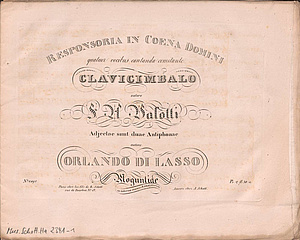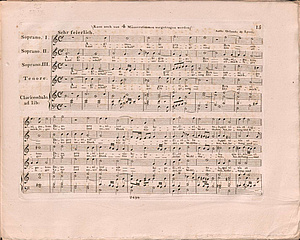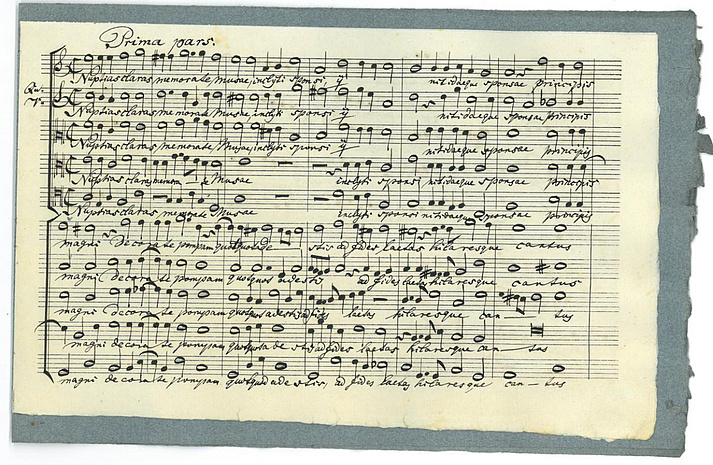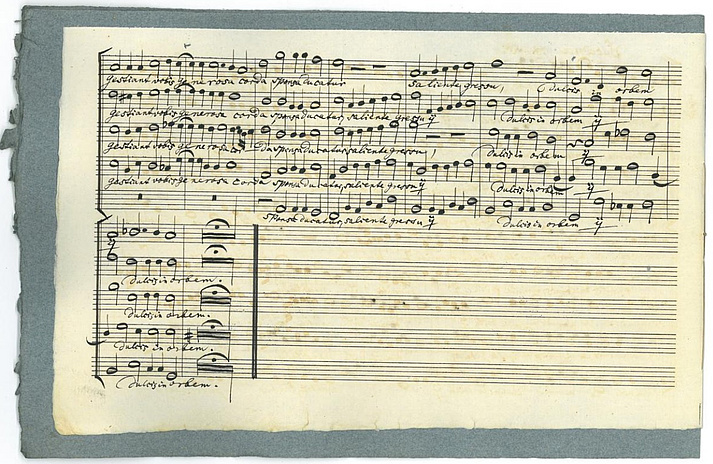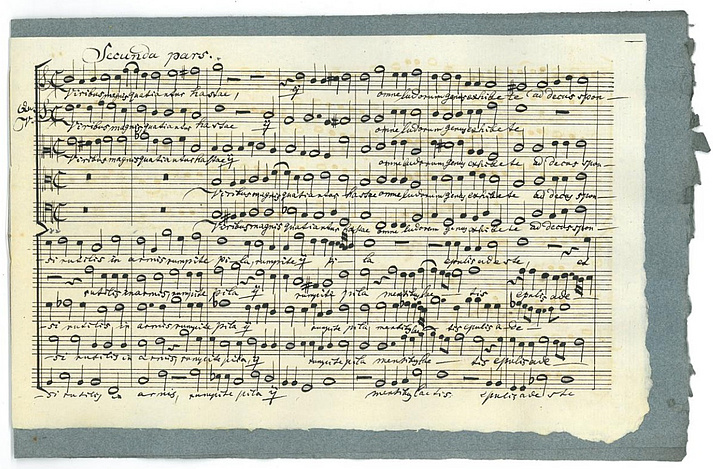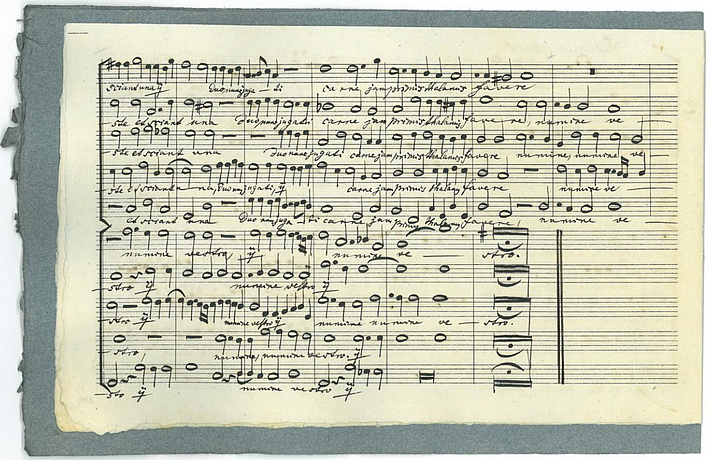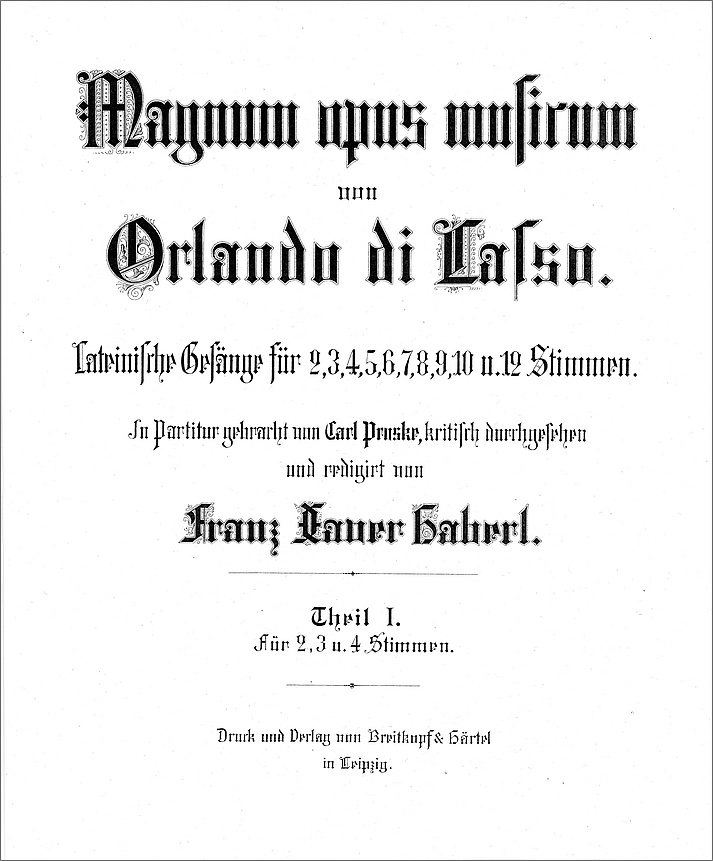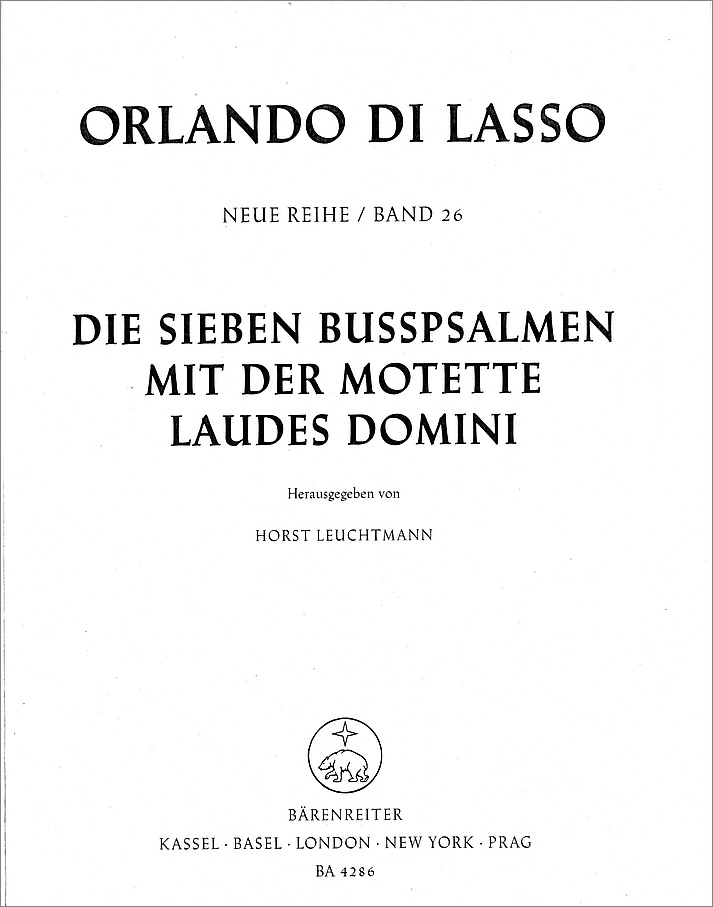History of Reception: Search through Time and Space
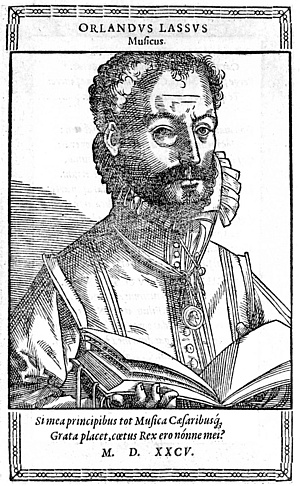
Lassus’ long history of reception is reflected in the large number of prints and manuscripts with his works well into the late 17th century. The last „contemporary“ Lassus printing was a mass published in 1687 – almost 100 years after his death in 1594. He was by far the most printed composer of his time. Approximately 1200 of Lassus’ about 1360 works are handed down in more than 480 preserved contemporary prints from the years between 1555 and 1687. Leading publishers in Germany, France, Italy and the Netherlands brought his works to market. Some compositions were printed and published more than thirty times, many at least twenty times. A bibliography by Horst Leuchtmann and Bernhold Schmid provides information about the printings: Orlando di Lasso. Seine Werke in zeitgenössischen Drucken 1555-1687, three volumes, Kassel etc. 2001.
There is also a virtually inestimable number of manuscripts with his music, listed in the database „Orlando di Lasso: Seine Werke in handschriftlicher Überlieferung“. Autograph music are not preserved. We know his handwriting from a number of letters and remarks in performance material.
Lassus’ Influence on Textbooks
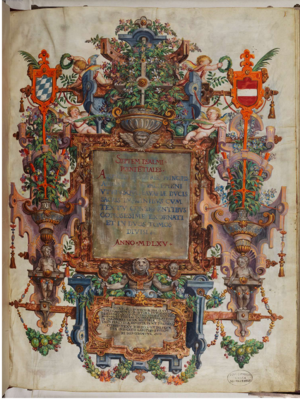
In music textbooks, Lassus counts among the composers most mentioned. Theoreticians like Gallus Dressler, Seth Calvisius and Maternus Beringer mention him a lot, quoting passages from his works as examples. Michael Praetorius praises Lassus’ motets in his Syntagma musicum from 1619 as epitomising the genre. Joachim Burmeister analyses Lassus’ motet In me transierunt in his Musica poetica from 1606.
Adam Gumpelzhaimer’s Compendium Musicae includes numerous examples from Lassus’ works as well. It was this textbook in particular that may have contributed significantly to his lasting fame, considering the fact that it was published in altogether 15 editions between 1591 and 1681, thus counted among the most influencial musical-didactic writings of the 17th century. Still in 1765, Giuseppe Paolucci published a two-part setting by Lassus as an example in his Arte Practica di Contrappunto dimostrata con Essempj.
The „Rediscovery“ of Lassus’ Music
Lassus was never really forgotten, so the idea of rediscovery in the proper sense does not quite apply. Moreover, even before Paolucci the then still young musicology had begun to address Lassus. We own handwritten scores made for studies from the middle of the 18th century. We also owe early comments on Lassus’ music to the music historian, composer and organist Charles Burney, who in the third volume of his General History of Music, published in 1789, actually made a rather negative judgement on Lassus. A very different opinion was held by John Hawkins: In his General History of the Science and Practice of Music (London 1776) he praises Lassus as „first great improver of figurate music“.
During the early 19th century, 16th century sacred music was eventually regarded as the ideal church music. In particular Giovanni Pierluigi da Palestrina was considered exemplary, therefore his style was imitated by numerous composers. Parallel to Palestrina other composers of the 16th century attracted attention as well; alongside Palestrina especially, Lassus was highly regarded. Carl Proske, a central figure in Lassus’ publishing history, compared Lassus with Dante and Michelangelo, while associating Palestrina with Raphael.
Publishing History
This is how Orlande de Lassus’ modern publishing history begins. One of the first printings with Lassus’ music is published by Schott in Mainz without indicating the year but assumed to be dated around 1825. There, the Latin text of the motets Agimus tibi gratias and Verbum caro panem verum are both supplemented by a German adaption. The first really important edition is the publication of Lassus’ Seven Penitential Psalms by Siegfried Wilhelm (Berlin 1838).
Franz Commer dedicated eight volumes of his series Musica Sacra to Lassus’ music, published in Berlin between 1860 and 1867. Carl Proske published two masses and 20 motets in the Musica divina (Regensburg 1853 und 1855).
Numerous other early publications could be listed, yet crucial for editing the music of Munich’s Hofkapellmeister (maestro di capella at Court) became Carl Proske’s handwritten music score of Lassus’ 516 motets (traditional counting). Proske wrote the scores for almost all of these pieces within the year of 1842. It was an almost inconceivable achievement, unfortunately he could only publish a selection of them.
In the course of the early 20th century German Youth Movement, a small selection of Lassus’ works (the Bicinia and various secular setting) was edited for amateur musicians, often with German texts, and thus known to a broader musically interested audience.
Manuscript pages with Nuptias claras by Orlande de Lassus, score written by Carl Proske (Bischöfliche Zentralbibliothek Regensburg, Pr-M Lasso V/43)
(Kopie 1)
Literature:
Bernhold Schmid, „[...] immer noch wenige Werke von Lassus.“ Zur Editionsgeschichte des Münchner Hofkapellmeisters. In: R. Emans / U. Krämer (Hrsg.), Musikeditionen im Wandel der Geschichte. Bausteine zur Geschichte der Edition 5, Berlin, Boston 2015, S.48-68.
Orlande de Lassus Complete Edition
Proske’s score became an important foundation for the today so-called Old Complete Edition Alte Gesamtausgabe. Franz Xaver Witt had already made plans for an edition of all of Lassus’ works in 1863, but the enquired publisher Breitkopf & Härtel saw no possibility of financing the project. The edition only started in 1894, when Franz Xaver Haberl, founder of the Kirchenmusikschule Regensburg, and Munich librarian Adolf Sandberger, later also founder of the chair of musicology at Ludwig Maximilian University in Munich, began publishing Lassus’ works. The edition of the motets in this publication is based on the scores written by Carl Proske.
The edition was eventually published by Breitkopf & Härtel but was put on hold in 1927 for financial reasons. Its 21 volumes include about half of the complete works. An outline of the edition in volume II reveals that the range of the project had not yet been clear.
With the Neuen Reihe (new series) the Bavarian Academy of Sciences and Humanities assumed the task of the Lassus edition. In 26 volumes, all published in the years between 1956 and 1995, the series published by Bärenreiter includes everything missing in the Alte Gesamtausgabe.
At the same time, also under the roof of the Bavarian Academy of Sciences and Humanities, a Zweite, nach den Quellen revidierte Auflage (Second Edition Revised in Accordance with the Sources) of the Alte Gesamtausgabe was published starting between 1968 and 2022 by Breitkopf & Härtel, complying with modern research standards.
Im Jahr 2021 wurde die Orlando di Lasso-Gesamtausgabe abgeschlossen. Die etwa 1350 Werke des Münchner Hofkapellmeisters liegen in insgesamt 47 Bänden vor, zudem sind die gedruckten Quellen für Lassos Musik in drei umfangreichen Bänden ausführlich beschrieben, die Handschriften sind in einer Datenbank erschlossen. Würdiger Abschluss des Projekts war das Symposion Orlando di Lasso, der Münchner Hofkapellmeister und die Gesamtausgabe seiner Werke, zu dem der Forschungsstelle eng verbundene Wissenschaftlerinnen und Wissenschaftler als Referentinnen und Referenten gewonnen werden konnten. (Die Publikation der Texte ist in Vorbereitung.) Dazu erklangen in einem Festkonzert des weltbekannten Münchner Vokalensembles Singphoniker ausgewählte Werke Lassos.
Orlande de Lassus in the Digital Age
In the meantime, parts of the print and manuscript sources for Lassus’ music (like the large holdings of the Bayerische Staatsbibliothek) have been digitised and are online accessible, which does made editorial work much easier.
In the frame of a rapidly growing interest in early music over the past 50 years, vocal ensembles dedicated to historically informed performance practice take on Lassus’ music presenting a number of outstanding CD recordings, parts of them with the support and consulting of the Lassus Edition.
Literature on Orlande de Lassus
Numerous works from the 17th and 18th century report on Orlande de Lassus and his biography. A lot of information can be traced back directly and indirectly to Samuel Quicchelberg’s article in Heinrich Pantaleon’s Prosopographia heroum […] totius Germaniae (Basel 1566). Quicchelberg lived at the Munich Court and knew Lassus in person, which is why his statements can be considered reliable. Over centuries, various misinformation found its way in though – like the one claiming that Lassus was born in 1520.
Research in the proper meaning of the word started in the 19th century. Following, a small selection of important literature is listed:
- An early, important work is Henri-Florent Delmotte, Notice biographique sur Roland de Lattre, connu sous le nom d’Orland de Lassus (Valenciennes [1836]), published in German translation with comments by Siegfried Wilhelm Dehn: Biographische Notiz über Roland de Lattre, bekannt unter dem Namen: Orland de Lassus (Berlin 1837).
- A number of works was presented by Adolf Sandberger, who also developed part of the Alte Gesamtausgabe. His Beiträge zur Geschichte der bayerischen Hofkapelle unter Orlando di Lasso. In drei Büchern. Erstes und Drittes Buch (München 1894 und 1895) are considered a milestone; a second book (Zweites Buch) was not published.
- An important French publication needs to be mentioned: Charles van den Borren, Roland de Lassus (Brussels 1943).
- A standard monography of the ‘life and work‘-type is Wolfgang Boetticher’s publication Orlando di Lasso und seine Zeit 1532 – 1594, Repertoireuntersuchungen zur Musik der Spätrenaissance (Kassel etc. 1958, 2. Edition Wilhelmshaven 1999).
- Similar in kind is Annie Cœurdeveys Roland de Lassus (Paris 2003).
- The still significant biography was written by Horst Leuchtmann, Orlando di Lasso: Sein Leben (Wiesbaden 1976).
- Serving as a catalogue of works is this biography by Horst Leuchtmann and Bernhold Schmid: Orlando di Lasso. Seine Werke in zeitgenössischen Drucken 1555–1687(Kassel etc. 2001). It also lists the few works handed down as manuscript only.
- The database Orlando di Lasso – Seine Werke in handschriftlicher Überlieferung was compiled by Tobias Apelt, Daniela von Aretin und Adelheid Schellmann and provides information on the manuscripts.
Other Research Activities of the Lassus Edition
At various congresses on Renaissance music Lassus often is a subject of discussion, some conferences were exclusively dedicated to him. Three of them took place on the premises of the Bavarian Academy of Sciences and Humanities: Within the frame of a large festival presenting music of Lassus and contemporaries, the Lassus Edition honoured the 400th anniversary of Lassus’ passing with a special conference. The conference report Orlando di Lasso in der Musikgeschichte can be accessed via BAdW Publication Server. In cooperation with the department of art history at the University of Salzburg, a symposium was organised on the Penitential Psalm Codex of Albrecht V. The music was set by Lassus, every page of the manuscript was elaborately illustrated by contemporary Munich painter and illustrator Hans Mielich, resulting in thousands of colourful miniatures (cf. conference report in Akademie aktuell 04-2017, p. 48-51.)
The conference report: Andrea Gottdang und Bernhold Schmid (Hrsg.), Andacht – Repräsentation – Gelehrsamkeit. Der Bußpsalmencodex Albrechts V. (BSB München, Mus.ms. A). Bayerische Staatsbibliothek, Schriftenreihe Bd. 8, Wiesbaden 2020.

